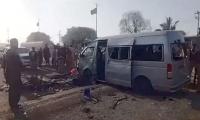On April 2 last year, Abiy Ahmed took over the premiership of a country on the brink of a major catastrophe. Three years of incessant protests across the restive regions of Oromia and Amhara, increasing ethnic violence and a deteriorating economy had brought Ethiopia to the verge of collapse.
The ascendance to power of a young, reformist leader, who was delivering a message of unity, prosperity, justice and peace, gave Ethiopians from all walks of life reason to become optimistic about the future.
For a while it seemed like the new prime minister, the youngest to hold high office in Africa in recent memory, was living up to the people’s expectations and more. Political prisoners were released, a landmark peace deal was signed with Eritrea, important political and economic reforms were put in place, and corrupt officials and human rights abusers were punished. Abiy’s initial achievements made many Ethiopia watchers believe the country was finally departing from the age-old politics of authoritarian survival.
While much progress was made on many fronts in the first few months of Abiy’s premiership, some deep-rooted challenges, such as ethnic tensions and internal displacement of peoples, continued unabated. Fortunately for Abiy and his new administration, many across the political spectrum preached patience and the citizens agreed that meaningful change would take time to implement. As a result, the support for the prime minister remained high.
However, a year into Abiy’s first term, public trust in the government seems to be in decline. Ethno-nationalists from different groups are continuing to defy the prime minister’s calls for pan-Ethiopian unity, keeping the possibility of conflict alive in several regions, as various groups continue to demand the right to form their own states under the federal system.
Issues such as displacement and home demolitions in the area around Addis Ababa, which caused ethnic tensions, mass protests and violence in the past, remain unresolved. People living on the outskirts of the capital are still being displaced, as their houses are being demolished without the due process the constitution affords them.
Instead of working to resolve these issues, ethno-nationalist Oromo politicians and officials, undoubtedly emboldened by the fact that an Oromo is now heading the federal government, are exacerbating the situation with inflammatory statements aimed at placating their ethnic group.
A video circulating recently on social media reportedly showed the president of Oromia regional state, Lemma Megersa, discussing plans to change the demographic composition of Addis Ababa and influence future election results by providing residence cards to Oromos displaced from Ethiopia’s Somali region. At a March 31 conference, Lemma declared his words were taken out of context and emphasised that he believed in “Ethiopian unity”.
Meanwhile, tensions in the West Guji district in Oromia region remain high. Thousands of ethnic Gedeos, who fled the area last year to escape ethnic violence at the hands of Guji Oromos are still languishing in refugee camps across the country.
The Oromo Liberation Front (OLF), which had been active in the region, made a deal with the federal government to lay down arms last year, but there have been reports that certain factions are still armed. The government for months has tried to downplay the power OLF still holds in certain parts of the country but locals continue to report attacks.
OLF members were also allowed to return from exile in Eritrea last year, which caused major unrest in Addis Ababa’s suburbs. Violence unleashed on minorities there killed 23 people in September. Today many people in the area live in fear of ethnic mob attacks.
Ethnic tensions are also simmering across Ethiopia’s Southern Nations, Nationalities and Peoples’ Region state, where over 40 ethnic groups once co-existed peacefully.
This article has been excerpted from: ‘Abiy’s year one: Ethiopia faces the threat of ethnic conflict’.
Courtesy: Aljazeera.com
A woman walks past a building of the International Monetary Fund. — AFP/FileThe annual and spring meetings of the...
Late Benazir Bhutto's daughter Asifa Bhutto Zardari addresses the Christian community in Bihar Colony on January 23,...
Representational image. — PexelsWater is an important scarce natural resource that is required for several everyday...
Pakistani employees of online marketplace company Kaymu at work in Karachi. — AFP/FileThe true spirit of development...
India uses Afghanistan as a backstage area to carry out terrorist attacks against Pakistan
Another report by the Pakistan Institute of Peace Studies states that 78 per cent of attacks have been carried out by...







